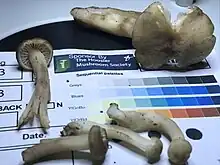Neohygrocybe ingrata
Neohygrocybe ingrata is a species of agaric (gilled mushroom) in the family Hygrophoraceae. It has been given the recommended English name of dingy waxcap.[2] The species has a European distribution,[1] occurring mainly in agriculturally unimproved grassland. Threats to its habitat have resulted in the species being assessed as globally "vulnerable" on the IUCN Red List of Threatened Species.[1]
| Neohygrocybe ingrata | |
|---|---|
 | |
| Scientific classification | |
| Domain: | Eukaryota |
| Kingdom: | Fungi |
| Division: | Basidiomycota |
| Class: | Agaricomycetes |
| Order: | Agaricales |
| Family: | Hygrophoraceae |
| Genus: | Neohygrocybe |
| Species: | N. ingrata |
| Binomial name | |
| Neohygrocybe ingrata (J.P.Jensen & F.H.Møller) Herink (1958) | |
| Synonyms | |
|
Hygrocybe ingrata J.P.Jensen & F.H.Møller (1945) | |
Taxonomy
The species was first described as Hygrocybe ingrata from the Faroe Islands in 1945.[3] Molecular research, based on cladistic analysis of DNA sequences, has, however, shown that it does not belong in Hygrocybe sensu stricto. Instead, the species has been moved into the related but separate genus Neohygrocybe, as already proposed on morphological grounds by Czech mycologist Josef Herink in 1958.[4]
Description
Basidiocarps are agaricoid, up to 110 mm (4 in) tall, the cap convex becoming flat, up to 60 mm (2.5 in) across. The cap surface is smooth, dry, often uneven, buff to yellowish brown, darker brown when old. The lamellae (gills) are waxy, thick, cream becoming pale brownish. The stipe (stem) is smooth, cream becoming brownish when old, lacking a ring. When cut, the whitish flesh turns slowly reddish brown and has a slightly chemical smell. The spore print is white, the spores (under a microscope) smooth, inamyloid, ellipsoid, measuring about 7 to 9 by 5 to 6.5.5 μm.[5]
Distribution and habitat
The dingy waxcap is widespread but generally rare throughout Europe.[1] Like most other European waxcaps, it occurs in old, agriculturally unimproved, short-sward grassland (pastures and lawns).
Recent research suggests waxcaps are neither mycorrhizal nor saprotrophic but may be associated with mosses.[6]
Conservation
Neohygrocybe ingrata is typical of waxcap grasslands, a declining habitat due to changing agricultural practices. As a result, the species is of global conservation concern and is listed as "vulnerable" on the IUCN Red List of Threatened Species.[1] The species is included in national Red Lists of 13 European countries[1] and is regarded as (critically) endangered in Croatia, Czech Republic, Denmark, Finland, France, Germany, Lithuania, Poland, and Switzerland.[1]
See also
References
- Kautmanova, I.; Knutsson, T.; Krikorev, M.; Læssøe, T.; Senn-Irlet, B. (2015). "Hygrocybe ingrata". IUCN Red List of Threatened Species. 2015: e.T71595761A71595999. doi:10.2305/IUCN.UK.2015-4.RLTS.T71595761A71595999.en. Retrieved 11 November 2021.
- Holden L. "English names for fungi". British Mycological Society. Retrieved 2022-10-10.
- Møller FH. (1945). Fungi of the Faröes, Part I: Basidiomyceten. Copenhagen: Munksgaard. p. 136.
- Lodge DJ; et al. (2014). "Molecular phylogeny, morphology, pigment chemistry and ecology in Hygrophoraceae (Agaricales)" (PDF). Fungal Diversity. 64 (1): 1–99. doi:10.1007/s13225-013-0259-0. S2CID 220615978.

- Boertmann D. (2010). The genus Hygrocybe (2nd ed.). Copenhagen: Danish Mycological Society. p. 200. ISBN 978-87-983581-7-6.
- Seitzman BH, Ouimette A, Mixon RL, Hobbie EA, Hibbett DS (2011). "Conservation of biotrophy in Hygrophoraceae inferred from combined stable isotope and phylogenetic analyses". Mycologia. 103 (2): 280–290. doi:10.3852/10-195. PMID 21139028. S2CID 318326.
